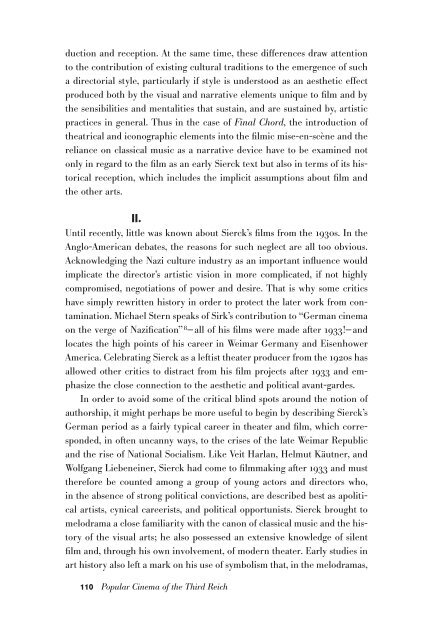You also want an ePaper? Increase the reach of your titles
YUMPU automatically turns print PDFs into web optimized ePapers that Google loves.
duction and reception. At the same time, these differences draw attention<br />
to the contribution of existing cultural traditions to the emergence of such<br />
a directorial style, particularly if style is understood as an aesthetic effect<br />
produced both by the visual and narrative elements unique to film and by<br />
the sensibilities and mentalities that sustain, and are sustained by, artistic<br />
practices in general. Thus in the case of Final Chord, the introduction of<br />
theatrical and iconographic elements into the filmic mise-en-scène and the<br />
reliance on classical music as a narrative device have to be examined not<br />
only in regard to the film as an early Sierck text but also in terms of its historical<br />
reception, which includes the implicit assumptions about film and<br />
the other arts.<br />
II.<br />
Until recently, little was known about Sierck’s films from the 1930s. In the<br />
Anglo-American debates, the reasons for such neglect are all too obvious.<br />
Acknowledging the Nazi culture industry as an important influence would<br />
implicate the director’s artistic vision in more complicated, if not highly<br />
compromised, negotiations of power and desire. That is why some critics<br />
have simply rewritten history in order to protect the later work from contamination.<br />
Michael Stern speaks of Sirk’s contribution to “German cinema<br />
on the verge of Nazification” 8 —all of his films were made after 1933!—and<br />
locates the high points of his career in Weimar Germany and Eisenhower<br />
America. Celebrating Sierck as a leftist theater producer from the 1920s has<br />
allowed other critics to distract from his film projects after 1933 and emphasize<br />
the close connection to the aesthetic and political avant-gardes.<br />
In order to avoid some of the critical blind spots around the notion of<br />
authorship, it might perhaps be more useful to begin by describing Sierck’s<br />
German period as a fairly typical career in theater and film, which corresponded,<br />
in often uncanny ways, to the crises of the late Weimar Republic<br />
and the rise of National Socialism. Like Veit Harlan, Helmut Käutner, and<br />
Wolfgang Liebeneiner, Sierck had come to filmmaking after 1933 and must<br />
therefore be counted among a group of young actors and directors who,<br />
in the absence of strong political convictions, are described best as apolitical<br />
artists, cynical careerists, and political opportunists. Sierck brought to<br />
melodrama a close familiarity with the canon of classical music and the history<br />
of the visual arts; he also possessed an extensive knowledge of silent<br />
film and, through his own involvement, of modern theater. Early studies in<br />
art history also left a mark on his use of symbolism that, in the melodramas,<br />
110 Popular Cinema of the Third Reich

















